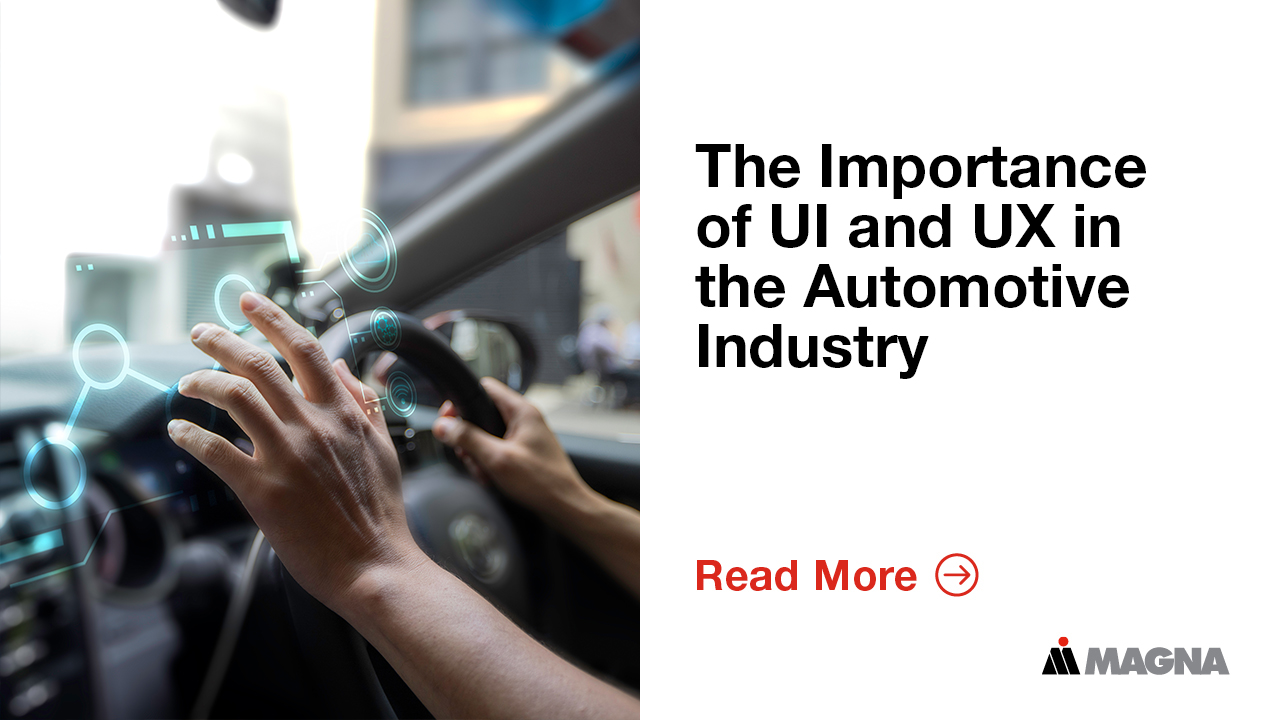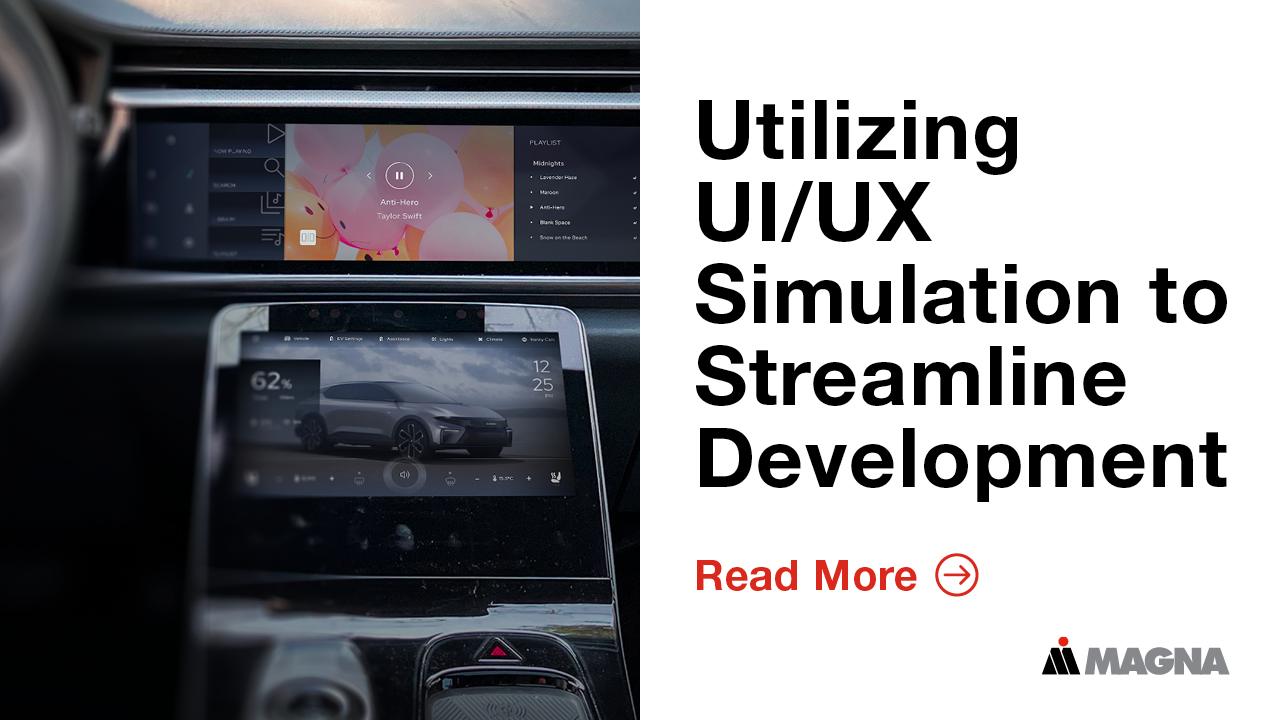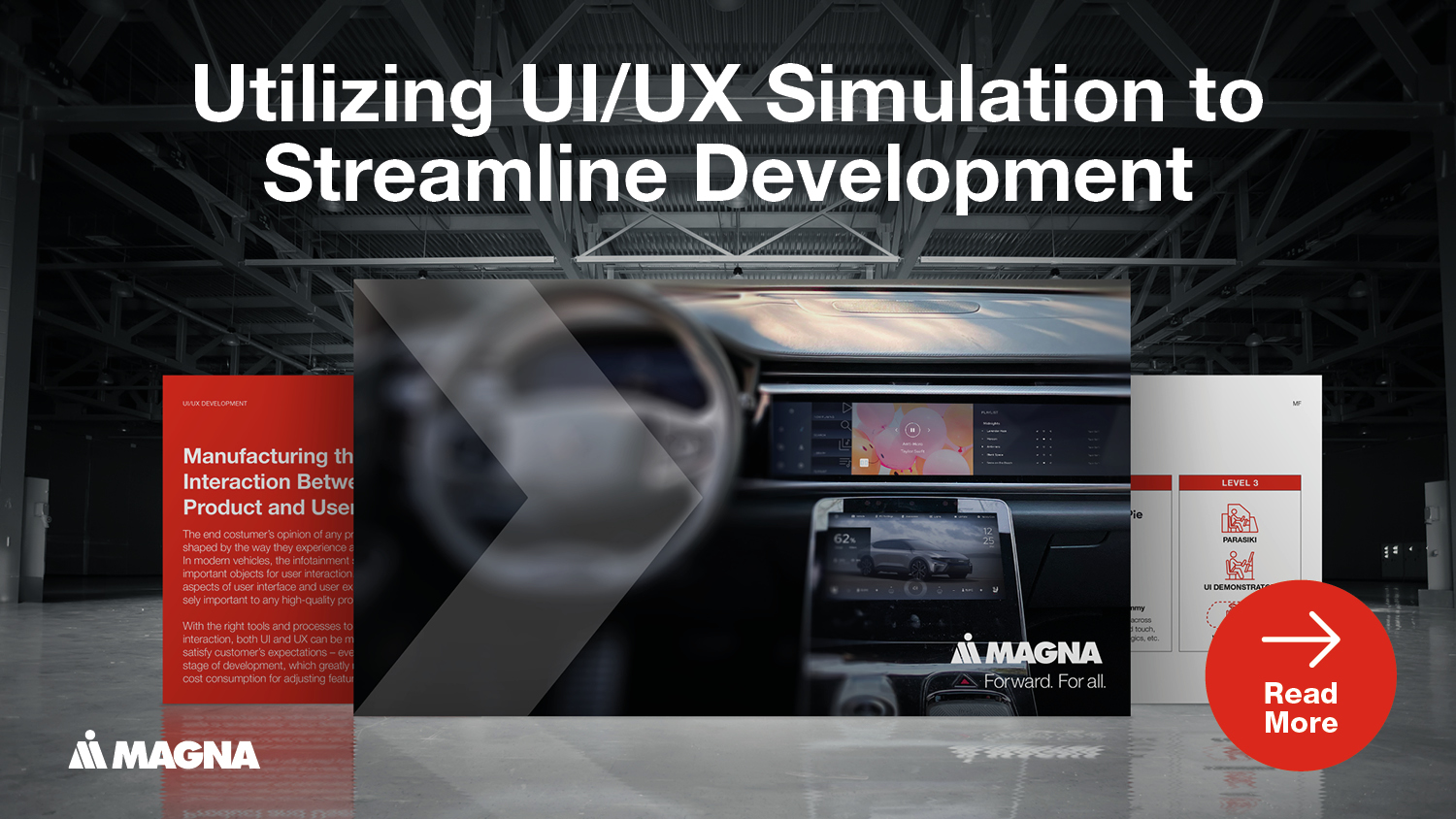
DEFINITION OF HMI, UI, AND UX
The Human Machine Interface (HMI) encompasses all interaction points between the driver or passenger and the vehicle. This includes mechanical elements like levers or buttons as well as digital interfaces like touchscreens, voice assistants, or gesture controls. UI and UX are specific aspects of HMI and can be defined as follows:
- User Interface (UI) refers to the design and structure of user interfaces. This includes visual elements such as icons, menus, and animations, as well as the arrangement of control elements and the logic of the operation process.
- User Experience (UX) describes the overall user experience that arises from the operation and handling of the vehicle. This includes aspects such as intuitiveness, ease of use, emotional connection, and the persuasiveness of functionality.
The two areas of UI and UX are closely linked and influence each other. A clear and well-thought-out user interface improves the user experience and thus the overall perception and experience of the vehicle.
THE INTERACTION OF UI AND UX
UI and UX work hand in hand to ensure seamless interaction between humans and vehicles. While UI describes the visual and functional design, UX ensures the subjective experience that the user feels. For example, the control of the radio: The UI includes the visual representation of the control elements, such as a volume slider or program buttons. UX considers how intuitively these control elements can be reached and how well they respond to user actions. Different user groups may have different expectations. Therefore, it is important to execute benchmark tests and user studies during the development phase to create a UX that is as universal and customizable as possible. This is collectively referred to as UI/UX design.
REQUIREMENTS FOR UX WITHIN THE OVERALL VEHICLE STRATEGY
The UX strategy is a central component of the overall vehicle strategy and is defined in the early development phases. This includes the analysis of target groups, market requirements, and legal regulations. An important role is played by the so-called Customer Market Profile, which describes which functions and features are particularly important for customers in a specific market or segment.
For example, users of premium vehicles place special emphasis on high-quality materials, comprehensive infotainment, and sophisticated comfort functions. In contrast, simplicity, functionality, and economy are the focus for a cost-effective city car. These requirements must be considered and optimally implemented in a coherent UI/UX concept. Often, there are already reference solutions on the market that a customer may want to orient themselves towards when developing a new display and control concept.
STRUCTURE OF AN UI/UX PROJECT AT MAGNA
A UI/UX project at Magna follows a clear structure based on the V-model. This model, with corresponding development and test phases, offers an iterative and traceable approach to vehicle development.
1. Strategy Phase
In this first phase, the basic requirements of the project are defined. The goal is to develop a comprehensive understanding of the customer and their expectations. An initial sketch serves as a starting point to define the interaction strategy: Should there be a single central display or a multi-screen solution? What role do voice control and haptic control elements play? These early decisions determine not only the user experience but also the technical feasibility and design direction for the concept phase. A clear strategic framework makes it easier to develop innovative and intuitive solutions for vehicle operation.
- Target Group Analysis: Who will use the vehicle, and what are the needs of this target group?
- Market Requirements: Which functions are indispensable in the target markets?
- Legal Regulations: Which standards and regulations must be met?
2. Concept Phase
Based on the strategic requirements, initial concepts are developed. These include the structure of the user interface, interaction patterns, and stylistic guidelines. In this phase, not only rough drafts are created but also detailed UI/UX concepts that define the layout, control concepts, interaction strategies, and the entire operation flow.
- Creation of Wireframes and UI Design: In addition to the structure and functionality of the UI, the visual design is also developed in this phase.
- Definition of UX Goals: How intuitive and pleasant should the operation be? What emotions should be evoked?
- Display and Control Concept for all Vehicle Functions: All vehicle functions must be provided with a clear interaction concept and evaluated through prototyping.
- Final Concept Description: The result of this phase is a comprehensive concept documentation that describes all displays, control elements, and interaction mechanisms.
This detailed elaboration forms the basis for the subsequent implementation and ensures a consistent user experience.
2.1 Prototyping
In the concept phase, Magna uses prototyping tools to concretize and iteratively test the concepts. Prototypes are a crucial means to make ideas tangible and integrate feedback early on. The range extends from virtual models to physical demonstrators.
- Virtual Prototypes: Tools like Figma or Adobe XD allow the creation of so-called click-dummies. These interactive models simulate the navigation through menus and the operation of functions on the screen.
- Hardware Demonstrators: These vehicle-like constructions offer the possibility to test control concepts under realistic conditions. A demonstrator can, for example, consist of a driver's seat with integrated displays, a steering wheel, and other control elements. Demonstrators of this kind are somewhat reminiscent of driving or racing simulators.
- Virtual Reality (VR) and Mixed Reality (MR): With the help of VR glasses, users can experience the interaction design in a virtual vehicle environment. Mixed Reality combines real demonstrators with virtual elements, enabling particularly immersive testing. For example, a demonstrator simulates the operation of the infotainment system via voice commands, gesture control, and touchscreen. Test subjects can provide direct feedback on whether the operation is intuitive or needs improvement. With VR, the fields of view in the vehicle or the ergonomics of the control elements can also be tested.
2.2 Evaluation through Prototyping and Implementation
The evaluation of the prototypes is carried out through extensive tests with users and stakeholders. Only after the final approval will the concepts be technically implemented and embedded in the vehicle architecture.
- Evaluation Loops: Regular feedback rounds ensure that requirements are met and problems are identified early.
- System Integration: The developed features must be seamlessly integrated into existing vehicle architectures.
3. Series Production
In the final phase, the implementation into series production takes place. Close collaboration with suppliers is crucial to meet the high requirements for quality and functionality.
CHALLENGES IN UI/UX DEVELOPMENT
The development of UI and UX is complex and brings numerous challenges. International standards for example must be considered. Varying legal requirements and cultural differences in the markets require flexible and scalable concepts. The technological integration of systems is also becoming increasingly important, as more and more vehicles will be connected to external infrastructure, such as traffic lights, in the future. Additionally, the networking of vehicles with each other poses high demands on data security. A consistent toolchain helps minimize errors. All development tools in a UI/UX project should be optimally coordinated.
DEVELOPMENT OF CONTROL CONCEPTS OVER TIME
In the last three decades, vehicle operation has changed drastically. Previously, mechanical switches, buttons, and analog displays dominated, while today digital interfaces are at the forefront. This is particularly evident in the entertainment sector, where the classic car radio with rotary knobs has evolved into a fully digitized info and entertainment system. Control concepts could hardly be more different. The integration of voice assistants and gesture control also shows the trend towards more intuitive and safer control concepts.
FUTURE OF UI/UX IN THE AUTOMOTIVE INDUSTRY
The coming years promise numerous innovations in the field of UI and UX:
- Augmented Reality (AR): Information such as navigation instructions will be projected directly onto the windshield.
- Autonomous Driving: The design of the interior will change as the focus is no longer on the driver.
- AI-supported Personalization: Systems that adapt to the preferences and habits of users will become standard.
CONCLUSION AND OUTLOOK
The importance of UI and UX in the automotive industry can hardly be overstated. They influence the functionality, safety, and emotional experience of modern vehicles. By using innovative technologies such as VR and AR, control concepts can be tested and optimized early on. Magna is well-positioned in this area and sees the increased use of Mixed Reality as key steps towards the future. Magna relies on innovative demonstrators in a UI/UX project to evaluate and optimize vehicle control concepts early on. By using Virtual Reality, design and control concepts can be tested already in the concept phase, reducing development costs and accelerating market launch. Augmented Reality is another evolutionary step that allows Magna to enable an even more realistic simulation of driving experiences and integrate innovative control solutions directly into the vehicle context. The UI demonstrator, as the core piece in the entire UI/UX process, always represents the current concept status. With extensive experience with traditional automakers and new players, as well as a structured development process, Magna sets new standards in the design of intuitive and future-proof vehicle interactions. These technologies will not only accelerate development but also advance the possibilities for vehicle design. Especially with a view to autonomous driving and the growing importance of the interior, new, immersive control concepts will play a crucial role.
Stay connected with Inside Automotive!

We want to hear from you
Send us your questions, thoughts and inquiries or engage in the conversation on social media.
Related Stories
Successfully Starting Series Production: Start-up Management in the Automotive Industry
Inside Automotive
Strategy and Prototyping in UI/UX Development for Vehicle Control Concepts on Behalf of Customers
Inside Automotive
Professional Risk Management and Financing in Automotive Serial Production
Inside Automotive
The IT Challenges for a Contract Manufacturer in the Automotive Industry
Inside Automotive
Stay connected
You can stay connected with Magna News and Stories through email alerts sent to your inbox in real time.



.tmb-widescreen.webp?sfvrsn=8d57edff_1)


